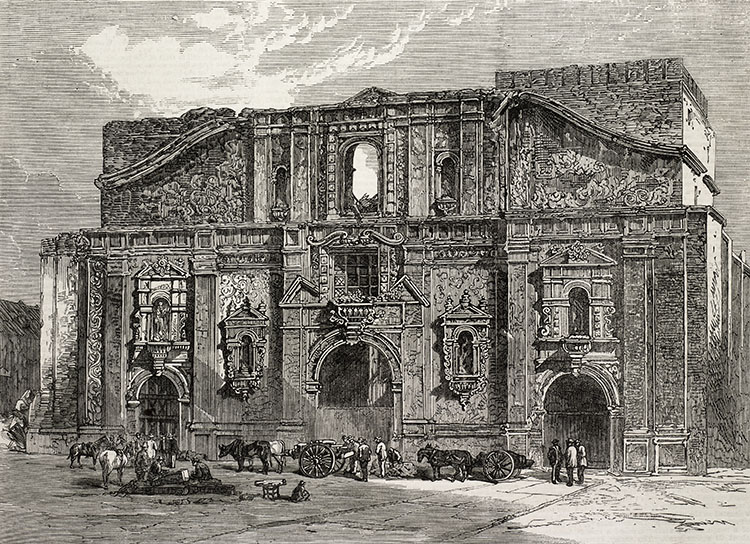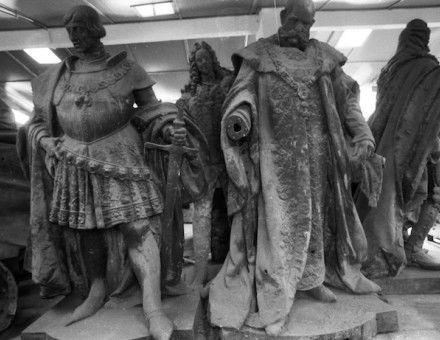Fire and Faith
The coverage of a disaster in Chile revealed religious divisions among the world’s press.

Late in 1863, a wayward lamp propelled an old church in Santiago, Chile, into world news. On the night of 8 December, members of the Archicofradía del Inmaculado Corazón de María (the Daughters of Mary) packed the Iglesia de la Compañía to celebrate the Immaculate Conception. Thousands of lamps and candles flickered, while banners and paper flowers decked the altars and columns. When a malfunctioning lamp set fire to the decorations, the flames quickly spread to the roof. Soon the doors were jammed with the fleeing congregation. As the event was for women, with hardly any men in attendance, the casualties were overwhelmingly female. More than 2,000 women and young girls died, a death toll exceeding any other accidental single-building fire.
Shock at the disaster spread around the world as newspaper after newspaper reprinted its colleagues’ stories. On 13 February, Le Monde illustré in France wrote that ‘everyone in Europe feels a poignant anguish’. In Richmond, Virginia, the fire shared the front page of the 26 January edition of Daily Dispatch with news of the ongoing American Civil War.
In Santiago, bereaved husbands, brothers and fathers founded a volunteer fire department and illuminated church services were banned. Many blamed the clergy, not only for its reckless use of decorations and lights, but also for luring their wives and daughters out of their homes.
The Month of Mary, which drew the crowd to their deaths, had only been inaugurated in 1854 to promote greater church participation. The Catholic Church in Chile had reason to encourage attendance. Many in Chile’s political elite had been trying to strengthen state power over the Church by establishing control over the tithe and other aspects of clerical behaviour. After the fire, calls for state control over the Church grew. As Sol Serrano demonstrates in her book ¿Qué hacer con Dios en la Republica? (What to Do with God in the Republic?), for the two decades following the fire, Chilean politicians slashed the powers of the Catholic Church. Yet, for all their deliberate attempts at curtailing its influence, most of Chile’s elite remained Catholic. El Ferrocarril, a prominent anticlerical paper, supported religious toleration and a less powerful clergy, but only within the context of a Catholic state. Only the Radical Party – the furthest to the left – believed in full freedom of religion and the separation of Church and state. Freemasons were prominent members of both the Radical Party and the new volunteer fire department. However, there were very few freethinkers in prominent positions and Protestantism, technically illegal, played little direct role in the events following the fire.
Most of the English-speaking world, to which news of the fire slowly spread, had opposed Catholicism to various degrees for three centuries. Its press, therefore, was much less sympathetic to the Church than its Chilean contemporaries. Many Protestant newspapers in the United States had mocked Irish and German Catholic immigrants for decades and the Irish Question was alive and well in Britain and the Empire. Thus, much of the English-speaking press blamed the disaster on inherent Catholic superstition, vanity and backwardness. In Paris in January 1864, L’Ami des Livres complained that ‘some English papers, bellicose vipers of Protestantism, have the audacity to blame the clergy of Santiago’.
Nevertheless, Irish Catholics were spread throughout the English-speaking world. In Sydney on 13 April, one Irish Catholic newspaper, The Freeman’s Journal, copied an account of the fire from the Valparaíso English Mercury but warned that it was ‘given by a bitter enemy to our faith’. The article in the English Mercury had criticised Father Ugarte of Santiago for draping his church in cloth and cardboard, filling it with lamps and candles and packing it with women and girls. It had also described ‘fanatics’ trying to push into the already full church. Many English-language papers reprinted it verbatim. The New York Times of 18 January printed several parts of it, along with other markedly anti-Catholic reports. One of the paper’s special correspondents wrote that ‘the iron-grasp of the priesthood in Chile will find they have not suffered in vain in this terrible disaster’ and referred to ‘Mariolatry’ and ‘superstition’.
In the English Mercury’s account, the clergy’s negligence extended to its rejection, in 1858, of a ‘convenient and safe’ plan for gas lights. The Santiago Gas Company had made a point of telling the city’s papers that the church did not have gas lights, after some early reports blamed gas for the fire.
Chilean and foreign newspapers noted that Santiago did not have working fire engines or an effective fire brigade; Chilean liberals and Radicals blamed former president Manuel Montt for quashing a plan for a volunteer fire department a few years earlier, because many of its organisers opposed him politically. On 13 February, Le Monde illustré noted that much of the church was wood, but accepted that as the standard architectural practice of an ‘earthquake-prone country’. But France, England and the United States had flammable buildings, too. In the 1860s the idea of ‘the modern city’ was being invented in many countries simultaneously and there was still a great deal to figure out.
As if to underline the international debate, the Launceston Examiner in Tasmania assumed that Santiago was a city that Launceston could learn from. On 12 April, a few days after reprinting the English Mercury article, and four months and four days after the fire, the paper suggested adding another staircase to the Launceston Mechanics’ Institute hall. The editors wrote that ‘the terrible catastrophe at Santiago ought to teach a lesson in the construction of churches and public buildings’, not just in Santiago, but ‘wherever intelligence of the Santiago calamity may reach’.
Thus Santiago’s horrific fire shocked the world and became one of the first of the long list of church, theatre and factory fires that forced industrialised countries to require ample exits in the first decades of the 20th century.
Samuel J. Martland is Professor of History and Latin American Studies, Rose-Hulman Institute of Technology.




